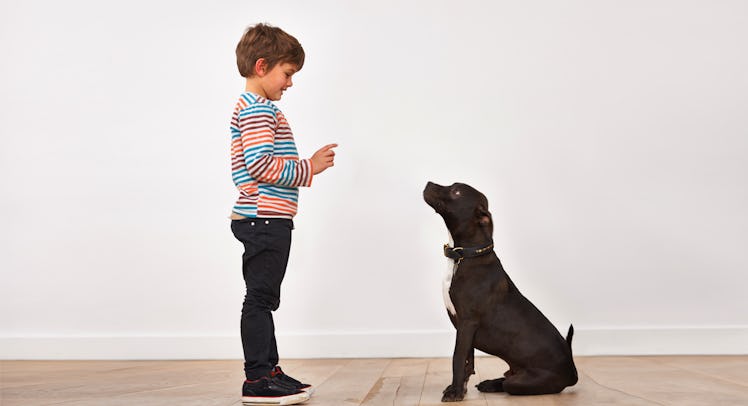How to Train Your Dog to Play Nice With Children and Babies
For parents who want to become dog owners, or dog owners who want to become parents, childproofing their dog is as imperative as house training it.

In Peter Pan, the plot begins when Mr. Darling demands that his wife no longer employ the family dog, a Newfoundland named Nana, as their children’s nanny. This is meant to be a sign of his hard-heartedness, but his logic is hard to dispute: Dogs were bred to do many things, but raising children is not one of them.
Mr. Darling was, of course, being lazy. Dogs are a big part of many families. While they don’t have an innate sense of how to behave safely around infants and toddlers, they simply need to be trained. Thus, for parents who want to become dog owners, or dog owners who want to become parents, childproofing the dog is as imperative as house training it.
Brian Kilcommons knows this. A world-renowned dog trainer and author of Childproofing Your Dog: A Complete Guide to Preparing Your Dog for the Children in Your Life, Kilcommons has spent more than three decades helping parents train their dogs to play nice with babies and toddlers.
For new parents, Kilcommons stresses to really stop and consider bringing a new dog into the mix. “People don’t realize, they’re bringing another baby into the house,” he says. If parents are dead set on bringing a dog into their family, he recommends they wait until their youngest child is at least five before they get a dog and even then they need to recognize the impact it will have on their daily routines. At least if the kids are older they can help to feed and walk and train the puppy. For those who have dogs and want to make sure their child and four-legged friend get along, he offered up these tips.
Start with command training
A dog cannot be childproofed (or taught much of anything) until it has been trained to follow the basic control commands: sit, down, and let go. Command training, per Kilcommon, not only enables you to assert control over the animal, but also to communicate and establish a relationship with it. It will also train you as an owner to read your dog’s behavior and accurately interpret its feelings.
Once you’ve mastered the basic commands, you can move on to more advanced training useful for a household with children. This includes teaching your dog to move aside when a person wants to walk by (thereby reducing canine-toddler collisions), to distinguish between baby toys and chew toys, and to stay calm when its tail is tugged.
Expose your dog to children beforehand
Being around adults does little to prepare a dog to be around young children. Children are smaller, louder, less predictable and sometimes aggressive. They even have a different scent. Confronted for the first time with such creatures, many dogs can become overwhelmed.
A crucial step in childproofing a dog is simply to expose it to children — playing, laughing, crying — until Bowser feels comfortable being around them. Proceed gradually: Invite some friends over who have older, well-behaved kids and see what happens. If that goes well, bring Bowser to the park where there are younger, more rambunctious kids. Owners need to be in control during each interaction, correcting bad behavior (overexcitement, barking) and rewarding the good.
Stick to a schedule
Having children obliterates your normal routine. But, per Kilcommons, owners need to try their hardest not to let it disrupt their dog’s. This means sticking to feeding and walking schedules. Dogs like schedules and need exercise and shouldn’t be deprived of either, especially while acclimating to life with children. Even if this requires one to hire a dog-walker to maintain this routine, make it happen.
Teach your child proper dog behavior
It’s critical that parents teach their children at a young age how and when to approach, pet, and play with dogs. In other words, a childproofed dog is one that is safe to be around a dog-proofed child. “The rule here is you do not allow a child to do anything to a dog or a puppy that you would not allow it to do to another child,” explained Kilcommons.
Never leave the dog and child alone
Per Kilcommons, even a fully childproofed dog should never be left alone with a young child. There is simply no predicting how an infant, toddler, or dog will behave, and so accidents are always a possibility. At times when parents aren’t in the same room as their children, Kilcommons recommends the old standby: the crate. “[Crates] usually can’t be opened by children where a door [to a room] can be,” he explained. “That’s not a punishment for the dog, it’s a safe place.”
Know when to get help (and when to give up)
Dog owners must stay vigilant for signs of aggression — low growls, wide eyes, hard stares — and seek professional help if you notice them. Aggressive behavior can be managed, of course, but it takes experience and will get worse if left alone. Kilcommons stresses that not all dogs are fit to be around children and vice-versa. Trust your instincts and err on the side of caution. The consequences of a mismatch between dog and child are just too great to risk.